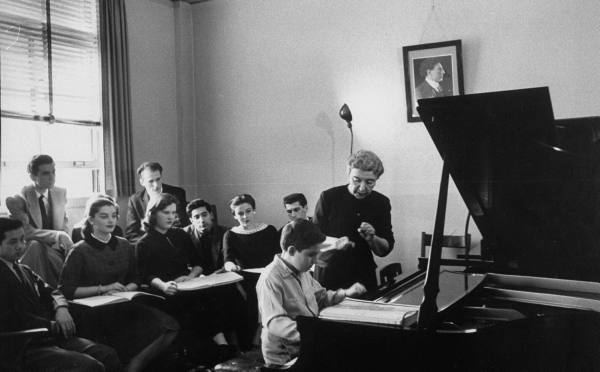“Masterclass” — the term makes me queasy. We had masters and slaves!
A French boss can still be referred to as “Maître,” as he is in Denis Dercourt’s sadistic, delightful film centering around the life of a pianist, La tourneuse de pages. There’s pervasive overuse of “Maestro” in orchestra land (“Will Maestro be joining us?”). My aunt Charlene, in best 1960s style, addressed my childhood birthday cards to “Master Bruce Brubaker.”
At New England Conservatory this spring we’re having four piano master classes given by distinguished visitors, Angela Hewitt, Stephen Hough, Richard Goode, and Leif Ove Andsnes. Leif Ove’s class last Saturday was very much a performer’s view. He spoke pragmatically, and technically. He went through every phrase that had been played. There were a few general observations.
Not only from Terrence McNally’s Master Class, a dramatized “reading” of Maria Callas’s classes at Juilliard, do we know that the “master”/diva can be imperious, or that the occasion can be transformative for the supplicant. Compelling, conceited, or cruel — master classes can be powerful. Gerard Souzay enraptured me, describing his voice traveling through space and returning from the back wall of the theater (Souzay fills the role for me that Charles Panzéra filled for Roland Barthes — Panzéra and Souzay, ideal amateurs). Leontyne Price seemed to pass an electrical current through her hand to jolt a junior Puccini-aria-singing soprano.

Witnessing instrumental mastery close up can free a too careful student — after hearing Janos Starker play her inferior instrument, a cellist poured out the opening of Dvorak’s concerto. The audience laughed as Starker had asked, “May I try your cello?”
With old-style classical piano teaching, I always wonder: Where’s the leap? From scrutinizing very specific details of touching the keys or closely reading one particular phrase to the large, lifelong discovery process necessary to the independent musician? A few students make the jump — seemingly no matter how they are taught. Some musicians excel at understanding how to play, others at explaining.
Before master classes in Israel, a colleague asked me: “Do you teach the music, or do you teach the student?” Silently, I thought, “Surely, it’s both.” But he went on to say, “You know Mr. Fleisher teaches the piece.” And it’s true that Leon Fleisher — following Arthur Schnabel and possibly Liszt — seldom hears a particular student play the same piece twice. He’s addressing the “eternal verities” of specific music. So, nothing more to say? Is classical music really such a constant?
In a master class in Korea, last year, John Perry heard a young virtuoso play all twelve of Chopin’s Opus 25 études. I guess she pretty much satisfied his sense of what the music is, or can be. After hearing more than thirty minutes of playing, he demonstrated a possible pedaling in a phrase of Opus 25, No. 7 (he played it beautifully), and then had nothing further to say.
So, I go to the master to learn exactly how to play Chopin’s First Ballade, then the Second. I have to go back to learn the Third Ballade, and the Fourth? Many past teachers must have thought they were passing on the specifics of a practice they had received. Many must have recognized that things did change. Czerny describes his teacher Beethoven’s playing (Opus 37), and then says that certain aspects of pedaling need to be adjusted to newer pianos.
So, I studied with a teacher who studied with a teacher who studied with a teacher who studied with a teacher who studied with Beethoven! Or (more shocking?), I studied with a teacher who studied with Arnold Schoenberg. What a game.
I’ve attended lessons with adult string players where an initial stage in studying a new piece was to take home the teacher’s music and copy all of the fingerings and bowings from it — no matter the student’s hand or instrument. A celebrated violin teacher sent her students to Juilliard’s library listening room to calculate and average together the tempos taken in five or six recordings of the new concerto to be learned. Imitation was a frequent form of teaching in art.
Some piano master classes feature the master pianist sitting at a second piano and demonstrating or even playing along with the student. What kind of subtle tonal listening can that encourage? (When I began teaching at New England Conservatory I had the second piano removed from my room.) Some piano-master-class-givers sit at a second piano (usually behind the student’s instrument and behind its raised lid). They listen from this acoustically compromised position throughout the student’s playing — they lie in wait. Nikolai Petrov second-piano-sat through an entire performance of Schumann’s Fantasy…
Famous performers can intoxicate, intellect can overwhelm. After an almost non-verbal master class given by a very celebrated visiting pianist, my colleague Patricia Zander observed, “I learned one thing today — he can play better than our students.” After my own master class at the Gilmore Festival last May, one piano teacher told me, “You gave an excellent master class, and you’re the least famous person here!”
Jean-Marc Luisada especially provoked me. Trying to get a student to play with more strength in the bridge of her hand, he closed the piano’s key cover and told her to play on the closed wooden lid. “Does that hurt,” he asked. She said it did. Luisada said, “Good, do it again!” Then, turning to the audience, he added, “You see, she is my slave.”

is that Rosina Lhevinne in the photo?
Yes, with a photograph of Josef Lhevinne hanging on the wall high above.
‘you see, she is my slave’
that’s quite a line.
I wonder if you could file a lawsuit with this?